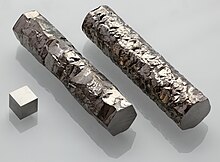Chemical element with atomic number 40 (Zr)
Zirconium, 40 Zr Pronunciation (zur-KOH -nee-əm Appearance silvery white
Atomic number (Z ) 40 Group group 4 Period period 5 Block d-block Electron configuration [Kr ] 4d2 5s2 Electrons per shell 2, 8, 18, 10, 2 Phase at STP solid Melting point 2125 K (1852 °C, 3365 °F) Boiling point 4650 K (4377 °C, 7911 °F) Density (at 20° C) 6.505 g/cm3 [ 3] when liquid (at m.p. ) 5.8 g/cm3 Heat of fusion 14 kJ/mol Heat of vaporization 591 kJ/mol Molar heat capacity 25.36 J/(mol·K) Vapor pressure
P (Pa)
1
10
100
1 k
10 k
100 k
at T (K)
2639
2891
3197
3575
4053
4678
Oxidation states common: +4 [ 4] [ 5] [ 6] [ 7] [ 8] [ 6] Electronegativity Pauling scale: 1.33 Ionization energies 1st: 640.1 kJ/mol 2nd: 1270 kJ/mol 3rd: 2218 kJ/mol Atomic radius empirical: 160 pm Covalent radius 175±7 pm Spectral lines of zirconiumNatural occurrence primordial Crystal structure hexagonal close-packed (hcp) (hP2 ) Lattice constants a = 323.22 pmc = 514.79 pm (at 20 °C)[ 3] Thermal expansion × 10−6 [ 3] [ a] Thermal conductivity 22.6 W/(m⋅K) Electrical resistivity 421 nΩ⋅m (at 20 °C) Magnetic ordering paramagnetic [ 9] Young's modulus 88 GPa Shear modulus 33 GPa Bulk modulus 91.1 GPa Speed of sound thin rod 3800 m/s (at 20 °C) Poisson ratio 0.34 Mohs hardness 5.0 Vickers hardness 820–1800 MPa Brinell hardness 638–1880 MPa CAS Number 7440-67-7 Naming after zircon , zargun زرگون meaning "gold-colored". Discovery Martin Heinrich Klaproth (1789) First isolation Jöns Jakob Berzelius (1824)
Category: Zirconium references
child table, as reused in {IB-Zr}
^ "Standard Atomic Weights: Zirconium" . CIAAW . 2024.^ Prohaska, Thomas; Irrgeher, Johanna; Benefield, Jacqueline; Böhlke, John K.; Chesson, Lesley A.; Coplen, Tyler B.; Ding, Tiping; Dunn, Philip J. H.; Gröning, Manfred; Holden, Norman E.; Meijer, Harro A. J. (2022-05-04). "Standard atomic weights of the elements 2021 (IUPAC Technical Report)" . Pure and Applied Chemistry . doi :10.1515/pac-2019-0603 . ISSN 1365-3075 . ^ a b c d Arblaster, John W. (2018). Selected Values of the Crystallographic Properties of Elements . Materials Park, Ohio: ASM International. ISBN 978-1-62708-155-9 ^ Zr(–2) is known in Zr(CO)2− 6 ; see John E. Ellis (2006). "Adventures with Substances Containing Metals in Negative Oxidation States". Inorganic Chemistry . 45 (8). doi :10.1021/ic052110i .
^ Zr(0) occur in (η6 -(1,3,5-t 3 C6 H3 )2 Zr and [(η5 -C5 R5 Zr(CO)4 ]− , see Chirik, P. J.; Bradley, C. A. (2007). "4.06 - Complexes of Zirconium and Hafnium in Oxidation States 0 to ii". Comprehensive Organometallic Chemistry III. From Fundamentals to Applications . Vol. 4. Elsevier Ltd. pp. 697– 739. doi :10.1016/B0-08-045047-4/00062-5 . ISBN 9780080450476
^ a b Greenwood, Norman N. ; Earnshaw, Alan (1997). Chemistry of the Elements (2nd ed.). Butterworth-Heinemann . p. 28. ISBN 978-0-08-037941-8 ^ Calderazzo, Fausto; Pampaloni, Guido (January 1992). "Organometallics of groups 4 and 5: Oxidation states II and lower" . Journal of Organometallic Chemistry . 423 (3): 307– 328. doi :10.1016/0022-328X(92)83126-3 . ^ Ma, Wen; Herbert, F. William; Senanayake, Sanjaya D.; Yildiz, Bilge (2015-03-09). "Non-equilibrium oxidation states of zirconium during early stages of metal oxidation" . Applied Physics Letters . 106 (10). Bibcode :2015ApPhL.106j1603M . doi :10.1063/1.4914180 . hdl :1721.1/104888 ISSN 0003-6951 . ^ Lide, D. R., ed. (2005). "Magnetic susceptibility of the elements and inorganic compounds". CRC Handbook of Chemistry and Physics (PDF) (86th ed.). Boca Raton (FL): CRC Press. ISBN 0-8493-0486-5 ^ a b Kondev, F. G.; Wang, M.; Huang, W. J.; Naimi, S.; Audi, G. (2021). "The NUBASE2020 evaluation of nuclear properties" (PDF) . Chinese Physics C . 45 (3): 030001. doi :10.1088/1674-1137/abddae . Cite error: There are <ref group=lower-alpha> tags or {{efn}} templates on this page, but the references will not show without a {{reflist|group=lower-alpha}} template or {{notelist}} template (see the help page ).


